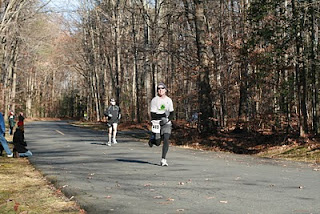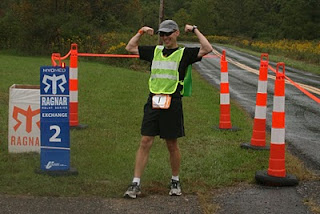Longest Ride of my Life
I shook off the dizziness that comes from a couple of hours in the water, and I got on "The Rocket." Each of my bikes has typically had a sweet name. The Cannondale Ironman 2000 was one of my favorite bikes I've owned, but looking at the photos now, I definitely should have sought a professional opinion on the fit. My body was stretched into a funny angle, which would not have been a problem for most rides, but a 6.5 hour long ride brings out the worst in everything and everyone.

My strength in 2006 is still my strength today -- I'm a solid biker. And I had trained harder for the bike than the other two disciplines (likely because it's the most fun training of the three). I had completed 5 century rides over the last 9 months. Although it was windy and I started way at the back of the pack, I started reeling in other bikers one by one. This is a pattern I've continued in the years since -- swallow my pride during the swim as people swim over the top of me, then inflate my ego while I pass them on the bike portion.
So what went wrong during the 112 miles on the road? In my (very) limited research on ironman training, I had read that cadence should be somewhere in the 90-95 rpm range at low resistance. This may have been a good strategy for a hilly course, but this course was totally flat. The result of spinning so fast was that my knees got inflamed and my IT bands got incredibly painful around mile 100. I had never gone more than 100 miles in training, but I had assumed that the extra 12 miles would be a snap. At about mile 100, my left knee in particular was so painful, I got off my bike at a porta-john and had a mini-breakdown.
When Things Look Bad
I recently read an interview with a pro triathlete who said that in extreme-distance events, there will be times when you feel extreme euphoria, and other times when you feel like you may never walk again. The important thing is to remember that both of these times will eventually pass, and you'll get back to normal racing again. At mile 100, I definitely felt like I would never walk again. The next 12 miles, I blew what would have otherwise been a respectable bike split. With the wind at my back, I pedaled the minimum possible to get me home. Each pedal stroke brought more pain from my left knee.

As I rolled (and I mean rolled) into the bike finish I couldn't hold it back anymore. I sobbed uncontrollably in front of everyone, including Alisha. In fact, I think that's the first time she had ever seen me cry. I wasn't crying just because of the pain -- I was crying because even though I was not as prepared or as experienced as I should have been, I had nonetheless worked very hard for a solid 9 months. The bad night's sleep, the early morning Seminary, the jellyfish stings -- everything seemed to have gone wrong. Alisha and I hugged, and I told her I was done for the day. A volunteer handed me my "run" bag, and I decided I would change out of my bike clothes while Alisha looked for a doctor.
Why I Love Triathletes
In the changing tent, I wasn't the only one in bad shape, but I was the only one quitting. I sat down to change my shoes, and another competitor said, "You can't just give up. None of us feel great. At least start walking." He handed me 4 ibuprofen and told me to "drink lots of water or you'll ruin your kidneys." When I came out of the tent, I told Alisha I was going to try. In a momentary lapse of her cheerleading, she said, "You don't have to do this! Stop now!" (For the record, this is the only time she has ever tried to talk me out of a race.) I still could not bend my left knee, but I started hobbling away from the transition area.
At about 100 meters, I couldn't stand the pain. I started sobbing again and turned around. Almost immediately, another competitor grabbed me by the shoulders and physically turned me around. "Come on, keep going." This is why I love triathletes -- they are as competitive as any other athletes, but they will not hesitate to help a struggling competitor. It happens every race, and I have tried to return the favor anytime I get the chance. I made it to the aid station at mile marker 1, and again started to turn around. Yet another competitor said, "Don't quit -- just keep going." So I did.
Pick the Next Object ... and Run to It.
When did I first get interested in Ironman? In eighth grade, a guest speaker came to speak to us. He was one of the early Ironman triathletes -- I unfortunately can't recall his name -- and he gave a slide presentation on his experience at Kona. His description of the race was heroic and sowed the seeds of my future obsession with multisport. But the part of his presentation that I recall most clearly is that of the run.
He explained that when he thought he could go no further, he picked one object -- a telephone pole -- and told himself that he could run to that pole, and that he would be all done. Before he got to that object, he picked another object and set the same goal. In doing this, he made his way to a 5th place finish at Kona. I certainly wasn't in the running for 5th place, but I was running out of time. In iron-distance events, if you do not complete the race in 17 hours (basically by midnight), they pull you off the course. I did the calculation, and if I walked, I would run out of time several miles before the finish. At this point, I was committed to finish, and I didn't want to come up short. So I picked a telephone pole and started running toward it. Then I picked another, and another, and another. I did this for almost 17 miles, largely propped up on an unhealthy dose of ibuprofen. The only interruption was a big vomit, right in front of an aid station. (This has also become a tradition in long-distance triathlons.)
It was pitch black outside, but I had bought myself enough time, I could walk the last 6 or 7 miles. For the record, THIS TAKES FOREVER! I don't recommend it unless you are on the verge of dying (as I felt I was). I've been very fortunate in my life not to have any major accidents or injuries. But during the last few miles of ChesapeakeMan, I could have died and it just wouldn't have surprised me. I could barely move my legs, I was bleeding in a variety of places, and I was completely out of energy. The "sag wagon" -- actually an ambulance -- kept creeping up behind me like a vulture, just waiting for me to take a fatal stumble. He even flashed his lights periodically, as if to say, "Just give up. You're done." But I kept waving him off. At the aid stations, I could hear the staff running through the small handful of competitors still on the course. "Yeah, number 108 is still out here..."
The Finish
At the final mile marker, Alisha met me, and we enjoyed a cup of chicken noodle soup. The two of us walked together for the last mile -- a special bit of support that I really needed. As we got near the finish line, I picked it up to the "ironman shuffle" (a walk that is designed to
look like running). Although it was close to 11pm, and the finish area was almost completely empty, the music was blasting and the announcer still called out my name. "Eric Lacey from Oakton Virginia!" They placed a big heavy medal around my neck, and all the pain and fatigue went away.
That's an iron smile!









































